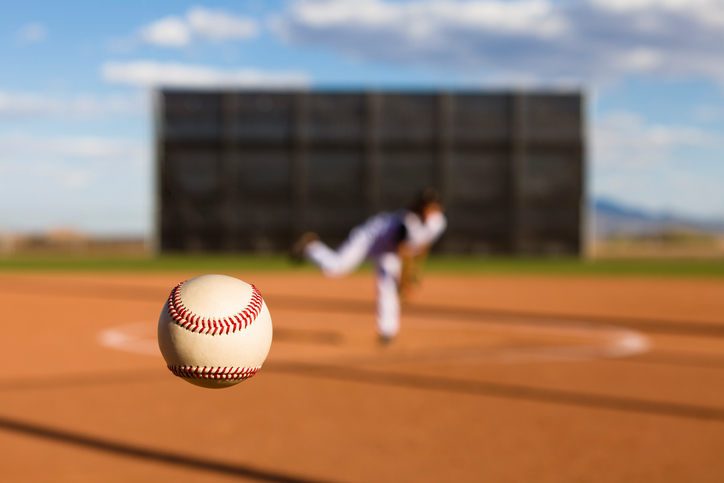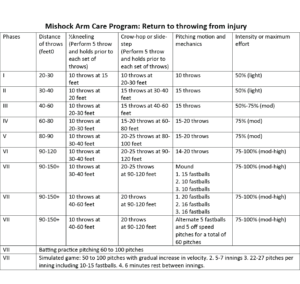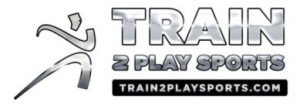
By Dr. John R. Mishock
The Mishock return to throwing program is a guide designed to gradually build the player’s throwing capacity when returning from an arm injury. All athletes are different through their age, genetics, previous training, physical conditioning, and previous injury. In that, care must be taken to modify this program to meet the specific needs of each thrower. The goal is to minimize the risk of re-injury while optimizing throwing performance by increasing the workload.
The gradual progression of the throwing program employs the rehabilitation principle of “specific adaptation to imposed demand” (SAID (Specific Adaptation to Imposed Demands) principle). The SAID principle means that the body will make physiological gains specific to the training at hand. Scientific evidence indicates that a progressive buildup of intensity, volume, and distance of throws best prepares the muscles, tendons, and ligaments for the rigors of a long throwing season.
Throw and holds:
A limiting factor in throwing velocity is the inability to decelerate the arm. As a protective mechanism, the body will not allow the acceleration of the arm to be greater than that which it can decelerate. Another word, throwing velocity is dependent as much on the accelerator muscles to propel the arm forward as it is the decelerators to slow the arm down. Weakness and poor motor control of the decelerator muscles of the shoulder will inhibit the accelerator muscle torque leading to decreased throwing velocity and potential injury. The act of throwing the ball works on the accelerator muscles to move the arm bone through the throwing motion. Holding onto the ball, without releasing it while going through the throwing motion, works the decelerator muscles (scapular and rotator cuff muscles) in an eccentric loading pattern while complementing the proper kinetic chain sequence used in throwing, which is the ultimate sports specific training.
Keys to success:
1. Proper warm-up is essential. Perform the dynamic warm-up, including legs, arms and shoulders.
2. Use proper throwing mechanics at all times to enhance neuro-motor learning and reduce arm stress.
3. Perform 5 throw and holds. 1. Use baseball or weighted ball. 2. Throw without releasing the ball.
4. After each set of throws, rest for 3- 5 min performing the shoulder stretches (Cross body, Over head, behind back) or a core exercise (side plank with hip abd, front plank with hip ext, push-ups)
5. Perform the throwing program 2-3 days per week with 1 rest day between throws.
6. Progress to the next phase each week if no arm soreness or re-injury.
7. For the younger baseball player, throwing will not progress passed the phase needed to compete at their level.
8. Active recovery following throwing: 1. Perform arm care elastic band strengthening exercises. 2. Perform static stretches. 3. Ice for 15 min. 4. Foam roll if necessary.

Arm Soreness Rules and Guidelines
1. It is common to feel small amounts of muscle soreness following throwing and or exercise. DOMS (delayed onset muscle soreness), typically a dull, diffuse ache is secondary to a buildup of lactic acid (a byproduct of muscle metabolism). However, we do not want the thrower to feel “their pain” related to the previous injury.
2. If there is no arm soreness, advance step by step through throwing program phases. Do not advance more than one phase per week without consultation with your physical therapist.
3. If the arm is sore during the first 15 throws and it does not improve, rest for 2 days and return to the previous throwing workout.
4. If the arm becomes sore after the first 15 throws, stop and take 2 throwing days off. Upon return to throwing, drop back 1 phase and progress through the program.
5. If soreness is evident for more than 1 hour after throwing, or the next day, take 1 throwing day off, and repeat the most recent throwing program workout.
6. If soreness does not decrease, seek a physical therapy or medical consultation.
Dr. Mishock is one of only a few clinicians with doctorate level degrees in both physical therapy and chiropractic in the state of Pennsylvania.
He has also authored two books; “Fundamental Training Principles: Essential Knowledge for Building the Elite Athlete” and “ The Rubber Arm; Using Science to Increase Pitch Control, Improve Velocity, and Prevent Elbow and Shoulder Injury”, both can be bought on Amazon.

If pain or limited function is keeping you from doing the activities you enjoy,
We can help!
Reduce pain and increase function
Call for a FREE Phone Consultation or to schedule your visit (610)327-2600.
Locations: Gilbertsville, Skippack, Phoenixville, Steiner Medical, Boyertown, Pottstown, and Limerick (inside the Spring Valley YMCA).
Appointments available 7:00am to 8:00pm, ALL locations, most days!
Saturday Appointments available
Visit our website to request an appointment, read informative articles, meet our physical therapy staff, and learn about our treatment philosophy.
